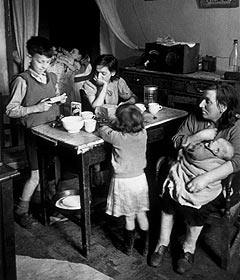Cathcart Report
Government reports can occasionally trigger knee-jerk reactions.
Edward Cathcart, Professor of Physiology at Glasgow University, knew all about them. He had earlier studied in St Petersburg under Pavlov, the Nobel Prize winner for his work on reflex reactions in dogs.
In June 1933 Sir Godfrey Collins, Secretary of State for Scotland, appointed a committee:
“to review the existing health services of Scotland in the light of modern conditions and knowledge, and to make recommendations on any changes in policy and organisation that may be considered necessary for the promotion of efficiency and economy.”
Cathcart became its chair. His report was a radical, visionary and comprehensive assessment of Scotland’s health. It ran to 404 pages.
Poverty and health
The report charted the improvements in life expectancy as well as the appalling deprivation that remained in industrialised Scotland where countless families were still condemned to huddling together in one and two-roomed tenement slums.
Cathcart recognised the “vicious circle in which poverty begets disease and disease begets poverty” and that housing, sanitation and environment were more important to health than standard medical interventions.
The answer was to turn health around by investing in resources into making good health and well being the everyday norm:
“Health education should be placed in the forefront of national health policy. It should aim at producing a people who are balanced physically and mentally who enjoy health and take it largely for granted because, by education and training, their outlook and habits are healthy.”
The response
The idea of putting the GP at the centre of health care was not new. It had already been advocated by two earlier reports (Lord Dawson of Penn in England and Sir Donald MacAlister in Scotland) in 1920.
Cathcart favoured an extension of the existing insurance system to pay for it. His recommendations were costed at nearly £20 million. Health Minister Aneurin Bevan’s route was different – funding would come primarily from general taxation.
But there was nothing Pavlovian in the response to the report. It was to have a huge influence in framing the broad consensus that led to the Scottish National Health Service.
Implementing Cathcart’s main recommendations required legislation. Westminster had more pressing priorities in the run up to war.
But some progress was made in improving maternity services. Better pay and status for midwives was a particular concern.
In the run up to 1948, Scotland had a recently agreed consensus through Cathcart on how to deliver a new service. There was no such blueprint in England.
Some Cathcart principles did find their way into the NHS but in a wider context rather than as the principal focus.
Cathcart was not specific on the vehicle for delivering a GP-led, health promoting service. The model was taken to mean new health centres in communities with a range of skills and facilities, dentists, pharmacists, and health visitors.
- Further information
- Development of health centres

Cathcart wanted an integrated and a personalised health service where individuals mattered and the GP was the key:
“The general practitioner, acting normally as family doctor, is an indispensable instrument of national health policy. . . . Without his assistance, as health adviser and as a principal liaison between the homes of the people and the statutory medical services, these services cannot, in modern conditions, function to the full extent as part of a comprehensive policy for promoting and safeguarding the health of the people.”
Cathcart was well served by the bright minds who were key players on his committee. They included:
Dr Mona Chalmers Watson – Edinburgh University’s first female medical graduate and a cousin of Elizabeth Garret Anderson.
Joseph Westwood – when introducing the NHS (Scotland) Bill as Secretary of State for Scotland in 1946, he made frequent and lengthy references to the report.
Robert Craig, Scottish Secretary of the British Medical Association which in 1935 represented half of Scotland’s doctors.
